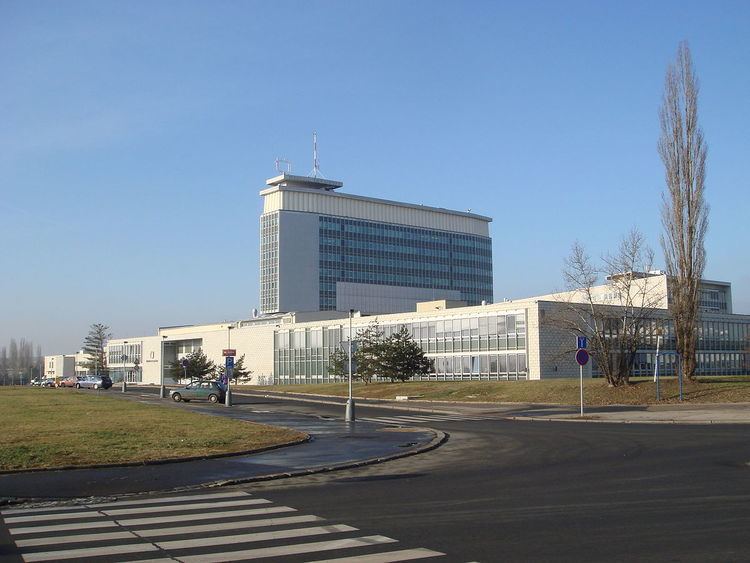Type Broadcast television Availability National Founded 1 January 1992 | Country Czech Republic Official website www.ceskatelevize.cz Launch date 1992 (1953) | |
 | ||
Slogan "Česká televize ve vašich barvách"
("Czech Television in your colours") Key people Petr Dvořák (since from 1.10.2011) CEO Petr Dvořák (21 Sep 2011–) Headquarters Prague 4, Prague, Czech Republic Owner Government of the Czech Republic TV shows StarDance, Vyprávej, Pat & Mat, Věříš si?, Three Kings Profiles | ||
Česká televize ( [ˈt͡ʃɛskaː ˈtɛlɛvɪzɛ], Czech abbreviation ČT, "Czech Television") is the public television broadcaster in the Czech Republic, broadcasting six channels.
Contents
Czechoslovak Television
Television in Czechoslovakia started to take its first steps before World War II. However, before visible results could be achieved, all activities were interrupted by the war. Research continued after the war, the first trial television broadcast was shown in 1948 at the MEVRO International Radio Exhibition in Prague.
A trial television broadcast from Studio Prague started on May 1, 1953, and on February 25, 1954 it was declared regular. Soon, additional studios were established: in Ostrava on December 31, 1955, in Bratislava on November 3, 1956, in Brno on July 6, 1961, and in Košice on February 25, 1962.
A second channel, ČST TV2, was launched in 1970. Colour broadcasting began on the second channel in 1973 and in 1975 on the first channel.
Czech Television
Czech Television was established as of January 1, 1992, based on the Czech Television Act (Act No. 483/1991 Coll.) as a television service for the citizens of the Czech Republic.
On January 1, 1993, a new concept of channels broadcast by Czech Television was introduced, which were renamed to ČT1 (formerly ČTV), ČT2 (formerly F1), and ČT3 (formerly OK3). On February 3, 1994, Czech Television freed one of the nationwide broadcast channels in accordance with the law; starting February 4, 1994 Czech Television was left with two channels, ČT1 and ČT2.
In 2005 news channel ČT24 and the following year ČT4 Sport were launched. In 2012, the broadcaster added two new channels, ČT :D (children's) and ČT art (arts/culture).
Czech TV Crisis
The "Czech TV crisis" occurred at the end of 2000 and lasted until early 2001 as a battle for control of the airwaves, which included jamming and accusations of censorship. During the Czech TV crisis, Czech TV reporters organized an industrial dispute by staging a sit-in and occupying the news studio and rejected attempts by Jana Bobošíková to fire them. They were supported in their protest by politicians such as the then President Václav Havel and by Czech celebrities, but every time they tried to air their news broadcasts, Bobošíková and Jiří Hodač would jam the transmission either with a "technical fault" screen reading: "An unauthorized signal has entered this transmitter. Broadcasting will resume in a few minutes", or with their own news broadcasts featuring Jana Bobošíková and a team she had hired to "replace" the staff members she had sought to terminate.
The Czech TV crisis eventually ended in early 2001, following the departure from Czech TV of Hodač and Bobošíková, under pressure by the street demonstration participants and at the request of the Czech Parliament, which had held an emergency session due to the crisis.
Funding and management
Česká televize is funded through television licence fees (larger part of revenue) and from advertising (where it is less successful than commercial television stations). During 2004 and 2005 the organisation lobbied the Czech government to increase the licence fee so that advertising could be eliminated.
Media occasionally raise questions about how much Česká televize is able to withstand pressure both from the governing parties and the opposition and maintain unbiased and critical coverage of politics. Most criticism are from left-wing and nationalist parties and groups. In long struggle with ČT is also president of Czech Republic, Miloš Zeman, who on last occasion unofficially suggest to create possibility for citizens who disagree with ČT, can pay compulsory television licence fee (in Czech Republic, every adult citizen have to pay TV licence fee, even if he or she does not have television) for charitable and social programs. Because of biased anti-Zeman and anti-leftist stances, some left-wing legislators (Jaroslav Foldyna and others) said they will vote against annual report of ČT until all financial connections of ČT will be revealed. In 2013 was publicly revealed information about incomes and salaries of ČT official Karel Burian, director of Brno ČT who earned in first half of 2011 nearly 2 million CZK (about 80,000 USD), which is much more than Czech Republic top politicians, including more than prime minister or president of Czech Republic.
The current General Manager of Česká televize is Petr Dvořák, who was elected for a six-year term by the Czech Television Council (Rada České televize).
